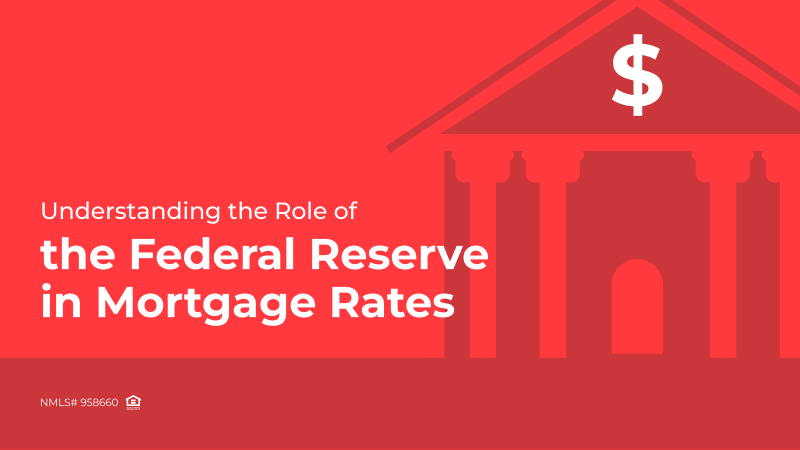Have you ever wondered why your clients’ mortgage rates seem to shift like the wind? Why are mortgage rates pegged to the rate set by Fed? It’s not just the whims of the market; a powerful force is at play: the Federal Reserve. The Federal Reserve, often referred to as “the Fed,” is like the central bank of the United States. This institution plays a key role in shaping the U.S. economy, influencing everything from inflation to employment. Its decisions ripple through the financial markets and have a direct impact on interest rates, including those tied to mortgages.
For mortgage professionals, knowing how the Fed operates and why its policies matter to their business isn’t just helpful – it’s essential. By grasping the Fed’s role, you can gain a deeper understanding of the market and offer more valuable insights to your clients, explaining to your clients the ‘why’ behind fluctuating rates. If you know how the Fed is likely to move, you can better anticipate how those changes will affect your clients’ borrowing power and their ability to afford a home.
This article will provide insights into how the Fed impacts mortgage rates.
What Does the Federal Reserve Do?
Before addressing the hot-button question of why mortgage rates are pegged to the rate set by the Fed, it’s necessary to get a clear understanding of what the Fed actually does.
Congress has given the Fed what is known as a “dual mandate”: to control inflation and foster employment. When inflation rises, the Fed works to stabilize prices so people can afford everyday essentials. When unemployment is high, it takes steps to make it easier for businesses to grow and hire workers.
To achieve these goals, the Fed uses a powerful tool: the federal funds rate. This is the interest rate banks charge each other for short-term loans. The Federal Open Market Committee (FOMC), a responsible group within the Fed, decides on this rate, meeting regularly to assess the economic situation and determine the best course of action.
When the Fed raises the federal funds rate, borrowing becomes more expensive. This can slow down the economy, which can help curb inflation. Conversely, lowering the rate makes borrowing cheaper, potentially stimulating economic growth and job creation.
These Fed actions, especially adjustments to the federal funds rate, have a significant impact on interest rates across the board, including mortgage rates. This is why understanding the Fed’s role is crucial for anyone involved in the mortgage industry.
How the Federal Funds Rate Impacts Mortgage Rates
Why are mortgage rates pegged to the rate set by the Fed? It’s not a direct, one-to-one relationship. As we’ve mentioned before, the Fed sets the federal funds rate, and when they raise it, borrowing costs increase across the financial system. This impacts investor behavior. Investors may shift their funds from riskier assets like mortgage-backed securities (bundles of mortgages) towards safer investments like Treasury bonds, which are considered one of the most secure investments because they’re backed by the U.S. government. This increased demand for Treasuries drives up their yield, particularly the 10-year Treasury yield. Because they’re safe, Treasury bonds have relatively low interest rates. Mortgage rates need to offer slightly higher returns than Treasuries to attract investors. Otherwise, why would anyone take on the added risk of a mortgage when they could buy a virtually risk-free Treasury bond?
Get the ADvantage
with our loyalty program
Earn and redeem points for valuable benefits for you and your clients
Unlock Rewards
So, when the yield (or interest rate) on Treasury bonds rises, mortgage rates often follow because lenders need to offer competitive returns to attract investment. Similarly, when Treasury yields drop, mortgage rates tend to decrease as well.
This connection is why the 10-year Treasury yield is often used as a benchmark for predicting where mortgage rates might go. While the two rates aren’t identical, they move in the same general direction because they’re both influenced by the same factors, including inflation expectations, investor demand, and overall economic conditions.
Even anticipated Fed’s actions may impact mortgage rates. According to CBS NEWS, “Mortgage rates often react to anticipated Federal Reserve rate changes before they happen. For example, if the Fed is expected to raise rates, lenders may raise their rates beforehand to avoid paying higher borrowing costs later. By contrast, when lenders expect the Fed to cut interest rates, they may lower their rates early to get ahead of the competition and encourage borrowers to lock in before others lower their rates.”
Fixed vs. Adjustable-Rate Mortgages: Impact of Fed Policies
Now, let’s take a closer look at how the influence of Fed rates on mortgages varies between the two main types: fixed-rate and adjustable-rate.
Fixed-Rate Mortgage
With a fixed-rate mortgage, a borrower’s interest rate remains the same for the entire loan term, so the Fed’s immediate influence might not be as obvious. However, the Fed’s decisions can still affect these rates by influencing investor behavior and the rates on government bonds. For example, according to Bankrate, “Fixed-rate mortgages are tied to the 10-year Treasury yield. When that goes up or down, fixed-rate mortgage rates follow suit. The fixed mortgage rate isn’t exactly the same as the 10-year yield, however; there’s a gap between the two. Typically, the gap between the 10-year Treasury yield and the 30-year fixed mortgage rate spans 1.5 to 2 percentage points. For much of 2023 and 2024, that margin grew to 3 percentage points, making mortgages more expensive.” Thus, the Fed’s influence on fixed-rate mortgages is more indirect and complex.
Adjustable-Rate Mortgage and Home Equity Lines of Credit
When it comes to adjustable-rate mortgages (ARMs) and Home Equity Lines of Credit (HELOCs), these loans have interest rates that change over time. They often adjust based on short-term benchmarks like the prime rate or the Secured Overnight Financing Rate (SOFR), both of which closely track the federal funds rate. For example, according to Citizens, the prime rate is typically “about 3% higher than the federal funds rate.” When the Fed raises the federal funds rate, it directly increases the cost of borrowing for these types of loans, leading to higher interest rates and potentially higher monthly payments for borrowers.
Overall, fixed-rate mortgages respond indirectly to Fed policy through long-term rates, while ARMs and HELOCs are directly affected, leading to more immediate changes in borrowing costs.
Key Factors Driving Mortgage Rates
Now that the answer to the question “Why are mortgage rates pegged to the rate set by the Fed?” is becoming clearer, it’s important to understand that the Fed’s actions are only one piece of the puzzle.
1. Inflation
One of the key drivers of mortgage rates is inflation. As previously mentioned, the Fed responds to the high inflation by raising interest rates to cool it down. The Fed’s goal is to make borrowing more expensive, which helps slow down consumer spending and reduces inflationary pressures. Increased interest rates, in turn, indirectly affect mortgage rates, resulting in their rise.
2. Employment Rates and Economic Growth
Employment rates and economic growth also play a vital role. A strong economy with low unemployment can lead to increased demand for housing and borrowing, potentially pushing mortgage rates higher. Conversely, a slowing economy can lead to lower demand and potentially lower rates.
3. Bond Market
Another factor that exerts a significant influence is the bond market. As we explained previously, government bonds, particularly the 10-year Treasury bond, serve as a benchmark for many long-term interest rates, including those for 30-year fixed-rate mortgages. As investors shift their funds towards government bonds, the demand for these bonds increases, which can drive up their yields. This increase in bond yields often translates into higher mortgage rates as lenders adjust their offerings to remain competitive.
4. Mortgage-Backed Securities
Mortgage-backed securities (MBS), bundles of mortgages, also play a role. These securities are traded in the market, and their prices can fluctuate based on investor demand and perceived risk. Changes in the value of MBS can impact the overall cost of borrowing for mortgage lenders, which can then be reflected in the rates they offer to borrowers.
Historical Trends: Examples of Fed Decisions Impacting Mortgage Rates
To better understand how the Fed impacts mortgage rates, it’s helpful to look at specific examples of the past.
During the pandemic, the Fed implemented unprecedented measures to support the economy, including slashing interest rates to near-zero levels. This dramatic shift significantly impacted mortgage rates, driving them to historic lows.
According to The Mortgage Reports, “By July 2020, the 30-year fixed rate fell below 3% for the first time. And it kept falling to a new record low of just 2.65% in January 2021.”
Borrowers enjoyed incredibly affordable rates, fueling a surge in homebuying activity.
Choose a top nationwide lender that cares about your growth!
Get Started
However, as the economy recovered and inflation began to rise, the Fed embarked on a series of interest rate hikes to curb inflation. These increases directly impacted borrowing costs, leading to a sharp rise in mortgage rates throughout 2022 and into 2023. As The Mortgage Reports notes, “With inflation running ultra-hot, mortgage interest rates surged to their highest levels since 2002. According to Freddie Mac’s records, the average 30-year rate jumped from 3.22% in January to a high of 7.08% at the end of October, emphasizing the dramatic shifts in mortgage rates history and the impact of economic conditions on borrowing costs.”
This rapid increase significantly impacted affordability, cooling the housing market.
These recent events demonstrate the Fed’s influence on the mortgage market. By analyzing historical trends, you can gain a better understanding of how Fed policies can impact borrower behavior and market conditions.
Why Brokers Need to Stay Informed
Staying informed about the Federal Reserve’s actions is essential for mortgage professionals. Understanding how Fed policies influence mortgage rates allows you to effectively educate your clients. Borrowers often have questions about fluctuating rates and their impact on their borrowing costs. By staying up-to-date on Fed decisions and their potential consequences, you can provide clear, concise, and accurate information to your clients, helping them make more confident choices, such as whether to lock in a rate or wait for possible changes.
In addition, leveraging knowledge of Fed policies can position you as a trusted advisor. Clients increasingly seek guidance from professionals who truly understand the mortgage market. By sharing insights from reliable sources, like the Federal Reserve’s monetary policy updates, you can demonstrate expertise and professionalism. This knowledge enables you to proactively advise clients on potential rate movements, explore alternative loan options, and guide them toward mortgage solutions tailored to their financial needs and goals.
Conclusion
So, why are mortgage rates pegged to the rate set by the Fed? It all comes down to how the Fed’s decisions ripple through the financial system. When the Fed raises interest rates, borrowing becomes more expensive for everyone, including banks and investors. This often pushes investors toward safer assets like government bonds, which drives up their yields. Mortgage rates, closely tied to these yields, tend to rise in response.
As a mortgage professional, understanding this connection isn’t just important – it’s essential. Knowing how the Fed’s actions affect rates allows you to educate your clients, address their concerns with confidence, and build stronger relationships. You’ll be better equipped to explain what’s driving rate changes, explore tailored loan options, and guide clients toward the best solutions for their needs. Staying informed about Fed policies and market trends ensures you’re always one step ahead, prepared to navigate shifts in the market effectively.
AD Mortgage is here to support you in this mission. With timely market insights and dedicated client support, AD partners with mortgage professionals to help them succeed. Together, we can deliver the expertise and guidance your clients expect. Join AD Mortgage today and take your business to the next level.
FAQ Section
Does the Federal Reserve directly set mortgage rates?
No, the Federal Reserve primarily influences interest rates through its monetary policy tools, such as adjusting the federal funds rate. This indirectly impacts mortgage rates.
Why do fixed mortgage rates follow the 10-year Treasury yield?
Fixed mortgage rates follow the 10-year Treasury yield because both are long-term interest rates. Investors compare the potential returns from mortgage-backed securities (which are riskier) to the safer, more stable returns from Treasury bonds. When the yield on Treasury bonds goes up or down, mortgage rates usually follow to stay competitive with these safer investments.
How do changes in inflation affect mortgage rates?
When inflation rises, the Fed typically raises interest rates to slow down the economy and reduce inflation. Higher rates lead to higher mortgage rates, making borrowing more expensive. Conversely, if inflation is low, the Fed may lower rates, potentially lowering mortgage rates.
What’s the difference between the federal funds rate and the discount rate?
The federal funds rate is the interest rate at which banks lend to each other overnight. The discount rate is the interest rate the Fed charges banks to borrow directly from it. The federal funds rate is more commonly referenced for broader economic impacts, including mortgage rates.
How can brokers use knowledge of Fed policies to better serve clients?
Brokers can use knowledge of Fed policies to predict rate changes and guide clients through rate fluctuations. By staying informed, brokers can offer timely advice, help clients decide when to lock in rates, and provide insights into how future Fed actions may impact borrowing costs.



